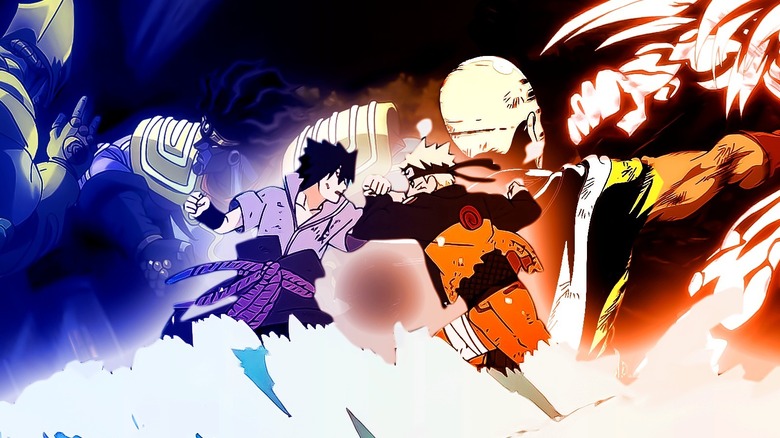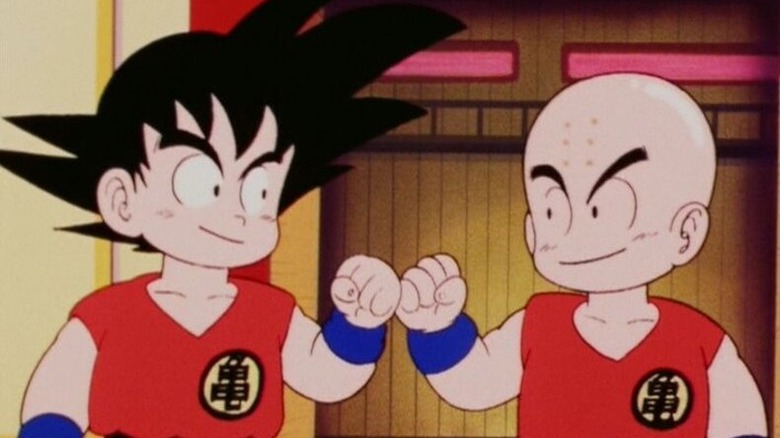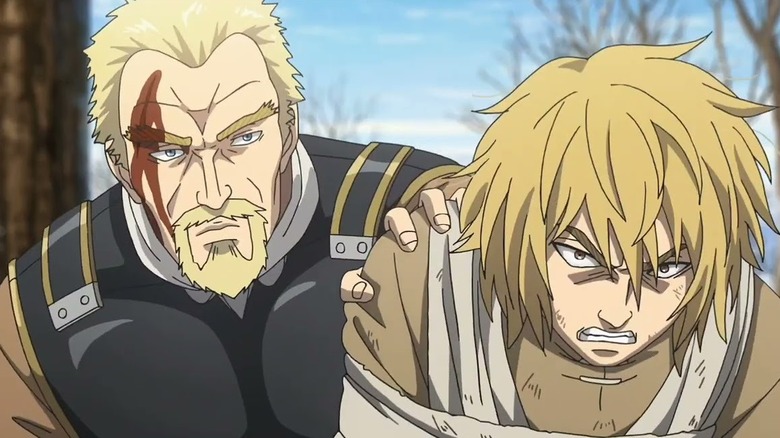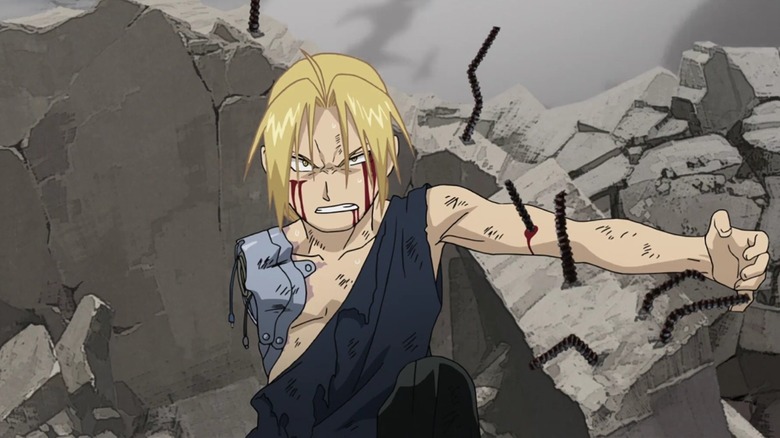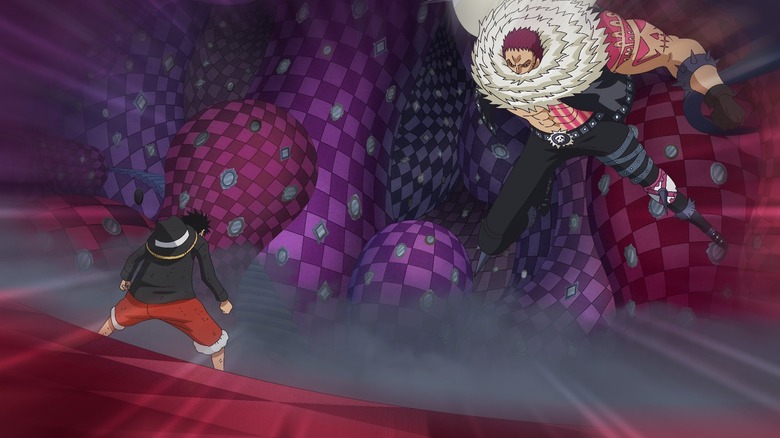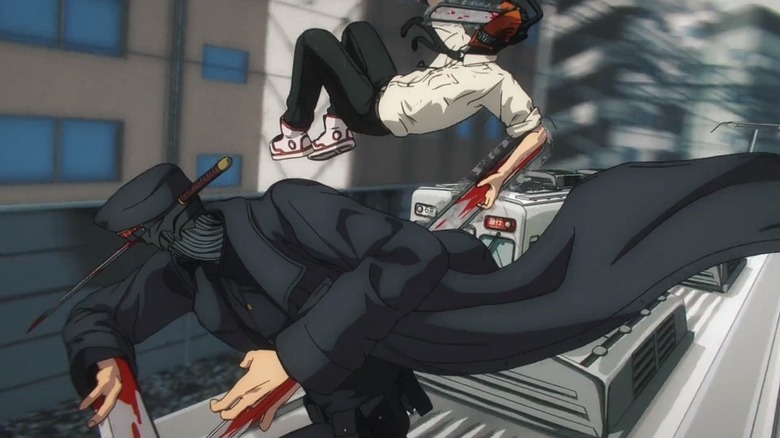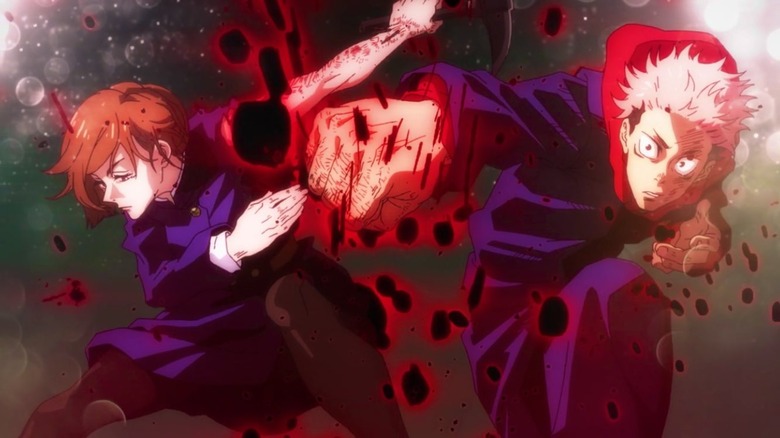The Top 14 Anime Fights Of All Time, Ranked
With its sense of kinetic animation, stylized choreography, and tendency to heighten spectacle for the sake of emotional stakes and scope, the anime medium has some of the best-rendered fight sequences in animation or live-action. Considering the ever-present reminder that anime is a medium, not a genre as occasionally misattributed, the fights can be as sci-fi as a multiversal martial arts tournament to a serene duel between samurai. With that in mind, here are the 14 best anime fights of all time, from the early days of concerted fight staging with the original '80s "Dragon Ball" to memorable scuffles from contemporary anime series.
Across such an exhaustive medium, many of the fights included in this article could stand as anime's very best but we've narrowed it down to singular, standout battles within different series and movies. Whether serving as the explosive punctuation to longstanding rivalries and character arcs or incorporating unique tactics and techniques, anime has delivered some truly impressive action set pieces. With anime becoming an increasingly prominent fixture of the mainstream, here are the best fights that the medium has to offer that everyone from seasoned fans to newcomers should check out.
14. Dragon Ball (Goku vs. Krillin)
In a lot of ways, "Dragon Ball" is both the gateway for a lot of viewers into the anime medium and a standard for anime fights, with everything from conventional martial arts to high-flying, energetic battles. The original "Dragon Ball" series, depicting the coming-of-age of the franchise's protagonist Goku, featured martial arts skirmishes from the beginning but the intensity and scope of these fights really found their footing approximately halfway through. This is visibly apparent during the tournament bout between Goku and Krillin at the World Martial Arts tournament in the series' third season.
In the lead-up to the tournament, Goku and Krillin had trained separately and their fight showcased how they had each individually progressed since their last meeting, especially Goku. On a more meta-textual note, the fight also revealed how much creator Akira Toriyama had honed his fight choreography, significantly upping the speed and emotional investment in every movement. Though perhaps not the most seismic struggle "Dragon Ball" has ever had, this duel definitely marks a turning point. The bar for the franchise's fights was quietly set by Goku and Krillin's skirmish, immeasurably helping "Dragon Ball" endear itself to millions worldwide.
13. Vinland Saga (Thorfinn vs. Thorkell)
Compared to the graceful martial artists and casually cool science fiction heroes leading other shows, "Vinland Saga" is nowhere near as elegant and that's by design. In the story of obsessive revenge framed against the backdrop of England at the height of the Viking Age, protagonist Thorfinn sets out to avenge his father's death. This leads Thorfinn to face off against his own uncle, Thorkell the Tall, with the two facing each other in a bitter rematch after an earlier skirmish costs Thorkell two of his fingers.
The second fight between Thorfinn and Thorkell runs longer than their initial duel, heightening the graphic violence as the uncle and nephew square off, culminating in Thorfinn breaking an arm and Thorkell losing an eye. Though Thorfinn has grown considerably as a fighter since he last fought his uncle, Thorkell overpowers him for much of the bout, easily knocking him around as Thorfinn endures a harrowing gauntlet of punishment. The ugliest and most visceral fight in this article, the duel highlights that "Vinland Saga" is well done but may not be everyone's cup of tea.
12. Attack on Titan (Eren vs. Reiner)
Hajime Isayama's "Attack on Titan" is part steampunk medieval fantasy, part kaiju horror as carnivorous Titans terrorize a walled city, vulnerable only in a weak point in the nape of their neck. Over the course of the series, protagonist Eren Yeager gains the ability to transform into a Titan himself, only to find that spies from rival kingdoms have infiltrated the military and similarly possess this power. Eren's friend Reiner Braun is among the double agents, able to transform into the Armored Titan, with the two friends' fourth battle standing as the action-packed highlight of the series.
Reiner takes part in Paradis' attack on Eren's kingdom of Shiganshina, transforming as he descends in midair to attack Eren directly, leading to a seismic brawl in the streets. Despite having greater endurance through his armored carapace, Eren is the superior hand-to-hand combatant and gets creative in how to outmaneuver his opponent in the grueling confrontation. As personal as fights in "Attack on Titan" get, Eren and Reiner's bitter brawl may go a bit too long but succinctly captures what the show is all about.
11. Fullmetal Alchemist: Brotherhood (Father vs. everyone)
The latter half of "Fullmetal Alchemist: Brotherhood" has a shadowy figure known as Father unleashing the homunculi, the sinister personifications of the seven deadly sins. Father is a particularly personal enemy for protagonists Edward and Alphonse Elric's estranged father, resembling their father Van Hohenheim after being made from Hohenheim's blood. After absorbing the soul of an omnipotent being beyond the Gate of Truth, Father ascends to godhood, resulting in Edward and Alphonse leading everyone to stop the villain from subjugating humanity.
The final battle with Father brings together all the surviving allies of "Fullmetal Alchemist: Brotherhood" for what is truly the most epic fight in either anime adaptation of Hiromu Arakawa's fantasy adventure. Father shrugs off the combined military might assembled against him and it's all hands on deck in the chaotic struggle. Perhaps a bit too overwhelming — and with Alphonse's heroic sacrifice to defeat Father undone too quickly and neatly in the aftermath — the Elric brothers' last stand is still a tremendous, extended set piece.
10. Cowboy Bebop: The Movie (Spike vs. Vincent)
Released two years after the conclusion of the main anime series, 2001's "Cowboy Bebop: The Movie" reunited much of the show's cast and crew for an all-new adventure. Set sometime during the events of the series, Spike Spiegel and his friends race to stop a terrorist named Vincent from launching an attack on the human capital on Mars. As Vincent prepares to carry out his chemical attack on a Halloween parade, Spike tracks down his adversary to a recreation of the Eiffel Tower overlooking the parade route.
All of the fight sequences in "Cowboy Bebop" are tightly choreographed while accentuating just how cool and competent Spike is, but its finale takes these sensibilities to another level. Spike and Vincent's showdown puts the viewer right in the center of its hard-hitting brawl while Spike's swagger and martial arts techniques quietly evoke those of Bruce Lee. Framed against the backdrop of Halloween on Mars under the pouring rain, this high-stakes confrontation perfectly embodies the sense of style that "Cowboy Bebop" excels at. Though, its conclusion may come a bit too clean.
9. One Piece (Luffy vs. Katakuri)
Eiichiro Oda's "One Piece" has become an enduring global phenomenon that has run for over 20 years and 1000 episodes as it tells the adventures of young pirate Monkey D. Luffy. Across the entire series, one of the most formidable opponents Luffy has ever faced is Big Mom Pirate Commander Charlotte Katakuri, who is a vicious hand-to-hand combatant. After several minor skirmishes, Luffy and Katakuri finally have it out in the 850th episode of "One Piece," in the most grueling challenge for Luffy yet.
In the face of Katakuri's overwhelming strength, Luffy essentially plays rope-a-dope with the rival pirate, enduring an intense, prolonged beating as Katakuri unleashes a barrage of attacks. As Katakuri begins to falter in stamina and Luffy grows accustomed to his fighting style, the Straw Hat Pirate turns the tables to defeat Katakuri in a stunning reversal. The only thing holding back Luffy and Katakuri's brawl is that Katakuri injures himself to make up for his sister Charlotte Flampe interfering in the duel in a display of honor. Still, this fight still stands head and shoulders above the rest in "One Piece" and demonstrates a quiet strategic side to the series' normally cheerful protagonist.
8. Chainsaw Man (Denji vs. Katana Man)
"Chainsaw Man" follows a group of monster hunters taking on devils evoking different animals and objects, with its protagonist Denji bonded to a devil himself to transform parts of his body into chainsaws. After the villainous Katana Man defeats Denji and escapes, Denji gets his chance at a rematch in the first season finale. The two opponents, who can both turn their appendages into deadly blades at a moment's notice, square off across the rooftops of Tokyo before their skirmish moves to a train speeding through the city.
Katana Man is one of the first enemies in "Chainsaw Man" to really put Denji in his place and nearly finish off the young monster hunter's career as it's just beginning. That lends both a heightened sense of danger and emotional investment in the rematch as Denji faces Katana Man alone, unmatched by any of the season's preceding battles. With Denji and Katana Man soaring across the cityscape before settling on a high-speed train, there is a constant sense of motion in this rematch that just makes everything feel that much more dire and thrilling. "Chainsaw Man" certainly captured a sense of grandeur before but this first season capper blended scope with personal stakes that will hopefully set a standard moving forward.
7. Jujutsu Kaisen (Yuji/Nobara vs. Eso/Kechizu)
"Jujutsu Kaisen" depicts a vision of Japan packed with fiendishly personified curses that terrorize the populace, prompting a private high school to train its students on how to hunt the curses down. The most frenzied battle for the series yet comes in the two-part finale to the anime adaptation's first season, with protagonist Yuji Itadori and his friend Nobara Kugisaki taking on two powerful curses at once. As the Death Painting Curse Kechizu is cornered, his older brother Eso attacks Nobara, leaving Yuji to continue his confrontation with Kechizu alone.
This heated two-on-two fight demonstrates just how formidable Yuji and Nobara have both grown since the start of the series in their most harrowing battle yet. With Eso and Kechizu both using respectively unique attacks and operating as a team, Yuji and Nobara are similarly forced to learn how best to work together to take on the dual threat. Blending supernatural horror with frenetic magical action, the "Jujutsu Kaisen" season finale showcases what the show does best before coming to an abrupt end.
6. Samurai Champloo (Mugen/Jin vs. Kagetoki/Toube)
If "Cowboy Bebop" serves a genre-defying blend of western, noir, and jazz influences, director Shinichiro Watanabe's follow-up anime series "Samurai Champloo" combines hip-hop with feudal Japan. Wandering figures Mugen and Jin form an unlikely friendship, despite Mugen being an irascible crook and Jin being a stoic samurai, with Mugen pursued by the villainous Toube, a violent figure from his past. As Mugen has his final showdown with Toube in the series finale, Jin takes on the cold, calculating assassin Kariya Kagetoki in a fierce sword fight.
Toube and Kagetoki offer a contrast in the types of antagonists across "Samurai Champloo," with Toube bitterly personal and relying on explosive tricks while Kagetoki is as reserved and analytical as Jin. A pair of gorgeously rendered sequences, from Mugen barely escaping Toube's suicide bomb attack to Jin drawing from his mentor's teaching to face Kagetoki, these dual duels feel like the true culmination of "Samurai Champloo." If "Cowboy Bebop" ends in melancholy, "Samurai Champloo" ends with understated serenity following its violent chaos and does so effectively.
5. Jojo's Bizarre Adventure: Stardust Crusaders (Jotaro vs. Dio)
The second season of "Jojo's Bizarre Adventure," subtitled "Stardust Crusaders," sees the vampiric villain Dio Brando emerge and target protagonist Jotaro Kujo and those close to him. Possessing the ability to temporarily freeze time, Dio is a sadistic enemy who kills Jotaro's reformed friend Noriaki Kakyoin and grievously wounds his grandfather Joseph Joestar. Despite the overwhelming odds against him, Jotaro takes on Dio in a brutal brawl that spans the final three episodes of the season.
What makes this fight stand above the rest in "Jojo's Bizarre Adventure" is its sense of dynamics in dominance, with Jotaro and Dio's control over the battle alternating in surprising turns across the skirmish. Dio's limited time manipulation makes for a visually interesting action sequence, while Jotaro's strategy in turning it against the vampire underscores how brilliant a tactician he can be. Sheer spectacle, Jotaro and Dio's showdown is a long time coming and a bloody masterclass on how to maintain a viewer's attention across such a prolonged conflict.
4. Naruto: Shippuden (Naruto vs. Sasuke)
If Naruto Uzumaki is the bright, inspired protagonist of the long-running anime series "Naruto: Shippuden," his opposite number is the coldly taciturn Sasuke Uchiha. Despite the difference in demeanor, Sasuke isn't an outright villain so much as just a recurring rival for Naruto as both ninjas embark on their respective adventures. When this rivalry inevitably comes to a head, both fighters engage in a brutal duel that brings out an uncharacteristically bloodthirsty side to Naruto as he prepares to end this feud for good.
Naruto and Sasuke's final fight is one of the highlights of the wider "Naruto" franchise, spanning several episodes as both characters beat each other within an inch of their lives. As a surprising denouement, the confrontation ends with Naruto and Sasuke sorting out their differences verbally, culminating in Naruto forgiving Sasuke for their shared animosity. While some may see the turn as something of a cop-out, it demonstrates how much both characters have grown and would help set the stage for Sasuke's road to redemption.
3. One Punch Man (Saitama vs. Boros)
True to its title, "One Punch Man" hinges on the gimmick of its goofy protagonist Saitama being able to dispatch even the more intimidating enemies with a single blow, with this fatal move occasionally delivered by accident. In contrast to the simplicity with which Saitama defeats his opponents, his greatest desire is to finally face someone worthy enough of withstanding more than one of his punches. This wish appears to come true at the end of the first season, with Saitama repelling an alien invasion led by the extraterrestrial conqueror Boros.
The battle begins (to Saitama's visible joy) with Boros surviving his first punch thanks to his otherworldly armor as the alien unleashes his full power. Following this, Saitama and Boros' resulting skirmish ends up tearing across the entire invading spaceship, creating widespread damage from within as they continue their duel. Of course, as with all things "One Punch Man," Saitama ends up easily taking down Boros with a single punch when he gets serious, but the fight leading up to this moment is a neon-lit showcase for the series.
2. Dragon Ball Super: Broly (Vegeta/Goku vs. Broly)
The entire "Dragon Ball" franchise has grown by leaps and bounds since the original anime series that ran in the '80s, both in terms of scale and the level of frenetic choreography in its action set pieces. This growth is apparent in the 2018 anime film "Dragon Ball Super: Broly," which pit Goku and Vegeta against the eponymous Legendary Super Saiyan being manipulated by the villainous Frieza. The action comes fast and furious in the movie, with Vegeta and Goku each taking on Broly individually before being forced to team up and take him together, to little avail against his sheer brute force.
"Broly" unveils a bunch of tricks to mix things up during the movie's centerpiece brawl, from first-person perspective sequences in the midst of the fighting to a rousing score composed by Norihito Sumitomo. Each blow carries a percussive crunch to it while every time a Saiyan powers up to a higher level, the entire tenor of the fight changes and escalates accordingly. "Dragon Ball" has become known for prolonging its major battles to the point of exhaustion; the highest compliment that can be paid to "Broly" is that we never want these fights to end.
1. Cowboy Bebop (Spike vs. Red Dragon Syndicate)
Though much of "Cowboy Bebop" is a sci-fi romp blending western and noir aesthetics set to an uptempo jazz soundtrack, the show takes a melancholic turn by its final stretch of episodes. After his long-lost love Julia is tragically killed, Spike has nothing left to lose and decides to take on the man responsible for her death, his arch-nemesis Vicious. Despite Vicious' entire crime syndicate sitting between the two longtime rivals, Spike launches a one-man assault on Vicious' headquarters to avenge Julia.
Each level Spike ascends in the syndicate's headquarters ups both the stakes against him and the emotional intensity of each subsequent set piece. This extended sequence really works best within the context of the larger "Cowboy Bebop" series, with viewers finally getting to learn why Spike is the way he is and getting to know him across two seasons. With the one thing Spike truly had to live for yanked away from him as soon as he reunited with Julia, he embarks on a vendetta guaranteeing his certain death. Emotionally, Spike is dead long before he reaches Vicious and the series' ending has the heartbreaking quality of watching this protagonist audiences have come to love lose himself to reckless self-destruction.
